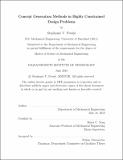Concept generation methods in highly constrained design problems
Author(s)
Proule, Stephanie V. (Stephanie Victoria)
DownloadFull printable version (21.74Mb)
Other Contributors
Massachusetts Institute of Technology. Department of Mechanical Engineering.
Advisor
Maria C. Yang.
Terms of use
Metadata
Show full item recordAbstract
Innovation and creativity are prioritized in engineering solutions, yet engineers and designers must also grapple with complex design problems which are highly constrained by requirements, regulations, and limited resources. This research seeks to understand the relationship between design constraints and concept generation methods in order to support innovation and creativity in the design of complex systems. A design study was conducted with 12 groups of civilian engineers from the Naval Undersea Warfare Center Division Newport. Participants were asked to generate concepts for two different design problems in which the ideation method and level of constraint were varied. Group brainstorming and a modified 6-3-5 method were used as a direct comparison, while a sketch modelling exercise was also incorporated to obtain qualitative observations and serve as a training exercise for participants. All generated ideas during the study were evaluated on four different ideation metrics: quantity, variety, quality, novelty. Constraint did not have a significant effect on quantity or variety; however low constrained problems produced statistically more novel ideas (for brainstorming only) and high constrained problems produced statically higher quality ideas (for both brainstorming and modified 6-3-5). The concept generation method has a marginally significant effect on the quality and variety; a modified 6-3-5 method produces a marginally higher quantity and brainstorming produces a marginally higher variety. Brainstorming produces significantly higher novelty and modified 6-3-5 method produces significantly higher quality (only for low constrained cases). The design task itself has a significant interaction effect on quantity, novelty, and quality of ideas generated which warrants further investigation.
Description
Thesis: S.M., Massachusetts Institute of Technology, Department of Mechanical Engineering, 2018. This electronic version was submitted by the student author. The certified thesis is available in the Institute Archives and Special Collections. Cataloged from student-submitted PDF version of thesis. Includes bibliographical references (pages 101-110).
Date issued
2018Department
Massachusetts Institute of Technology. Department of Mechanical EngineeringPublisher
Massachusetts Institute of Technology
Keywords
Mechanical Engineering.